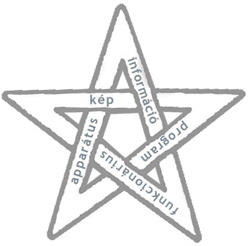Pythagoras’s (c. 580-520 BC) followers, called the Pythagoreans, linked the study of numbers with mystical phenomena. Their numerology was built upon the concept of proportion, and each number symbolised a concept. They regarded the number 5 as the perfect number of the human microcosm. Numbers 1, 2, 3, 4 and 5 meant “the root of the world”, and the equation 10 = 1 + 2 + 3 + 4 was the perfection of the world, i.e. divinity. They knew that the Earth was spherical and that it was in motion. Their favourite shape and mystical sign was the five-pointed star, or the pentagram, aka the Pythagorean star. [source]
Pythagoreans used this symbol as a sign of each other’s greeting and recognition, by drawing it in the sand when they met.

image | apparatus | functionary | programme | information
Recycled pentagram in the year of the five in Artpool, 2005
The pentagram is a five-pointed star, an uninterrupted line returning into itself after breaking five times and intersecting itself five times; because of the magical power exuding from it, it was once used to scare and ward off evil spirits, demons and other harmful creatures.
The pentagram was primarily attributed a magical power because manifest in its manifold is the proportion that was regarded as ideal and perfect for millennia, referred to for example as the golden section (sectio durea), the divine section (sectio divina) and the divine proportion (divina proportione), and the first definition of which is known (a:b=b:[a+b]) from the geometry book by Euclid.
In the Middle Ages and in the Modern era pentagrams were often painted onto or carved into the threshold of houses in Europe in order to protect the dwellers from evil and fend off demons.
Over time the magical pentagram gradually evolved into the prime symbol in magical practices. Today, the pentagram pointing upwards symbolises white magic and witchcraft, theurgy and the right hand path, while the downward-pointing pentagram stands for black magic and witchcraft, goetia and the left hand path. [source]
(English translation: Krisztina Sarkady-Hart)